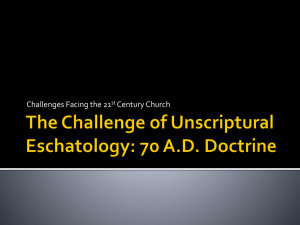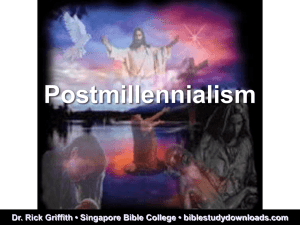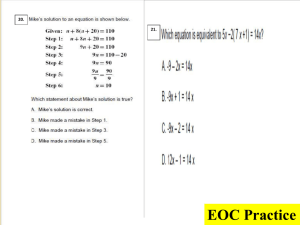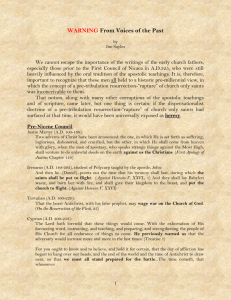Chiliasm – comes from the Greek word “chilioi” (Strong`s No. 5507)
advertisement
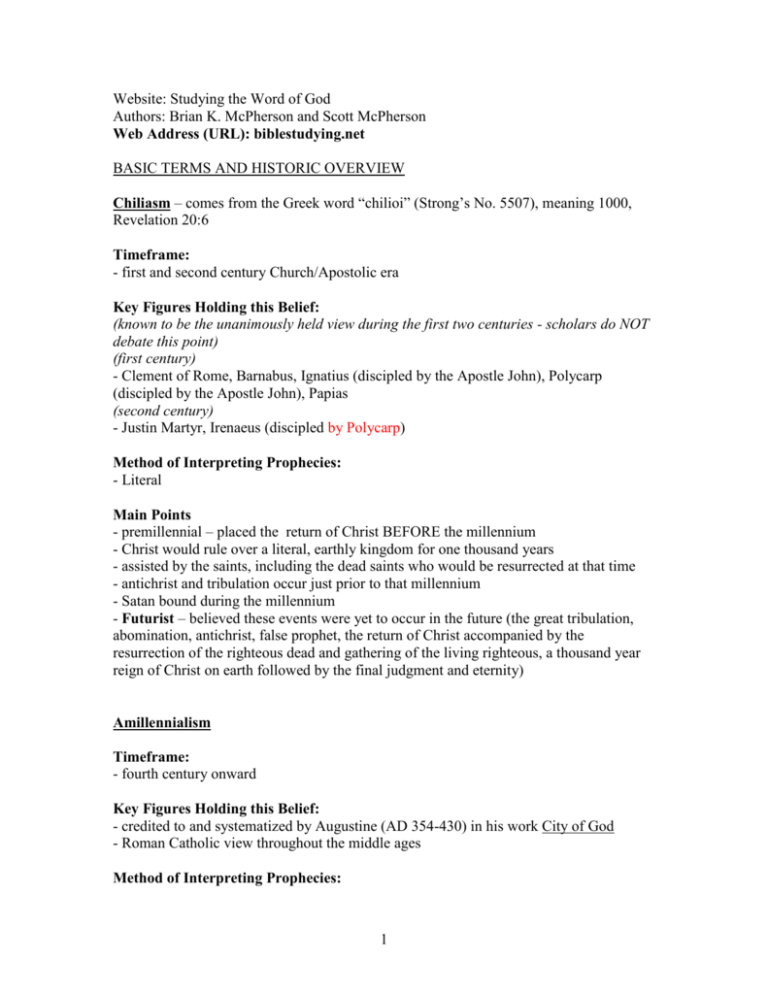
Website: Studying the Word of God Authors: Brian K. McPherson and Scott McPherson Web Address (URL): biblestudying.net BASIC TERMS AND HISTORIC OVERVIEW Chiliasm – comes from the Greek word “chilioi” (Strong’s No. 5507), meaning 1000, Revelation 20:6 Timeframe: - first and second century Church/Apostolic era Key Figures Holding this Belief: (known to be the unanimously held view during the first two centuries - scholars do NOT debate this point) (first century) - Clement of Rome, Barnabus, Ignatius (discipled by the Apostle John), Polycarp (discipled by the Apostle John), Papias (second century) - Justin Martyr, Irenaeus (discipled by Polycarp) Method of Interpreting Prophecies: - Literal Main Points - premillennial – placed the return of Christ BEFORE the millennium - Christ would rule over a literal, earthly kingdom for one thousand years - assisted by the saints, including the dead saints who would be resurrected at that time - antichrist and tribulation occur just prior to that millennium - Satan bound during the millennium - Futurist – believed these events were yet to occur in the future (the great tribulation, abomination, antichrist, false prophet, the return of Christ accompanied by the resurrection of the righteous dead and gathering of the living righteous, a thousand year reign of Christ on earth followed by the final judgment and eternity) Amillennialism Timeframe: - fourth century onward Key Figures Holding this Belief: - credited to and systematized by Augustine (AD 354-430) in his work City of God - Roman Catholic view throughout the middle ages Method of Interpreting Prophecies: 1 - allegorical/spiritual (this change leads to the demise of premillennialism) Main Points - no actual 1000 years - the visible church was the kingdom of God on earth - the millennium should be interpreted spiritually as fulfilled in the church - final judgment occurs immediately when Jesus Christ returns - the binding of Satan occurred during Christ's earthly ministry - the first resurrection should be identified with the new birth of the believer - the millennium coincides with the present church age - particularly for Roman Catholics, Christ was/is viewed as ruling on earth through the Church, specifically through the Pope as the “Vicar of Christ” - Many began to interpret the binding of Satan and the resurrection and reign of saints (Revelation 20:1-4) as the personal victory of believers over Satan - in that sense, believers are, in this present life, reigning with Christ Historicism (Originally an amillennial Position held by the Protestant Reformers) Timeframe: - 1500’s, Protestant Reformation Key Figures Holding this Belief: - Martin Luther (amillennialist) - John Calvin (amillennialist) - the Mormons, the Seventh-day Adventists, and the Jehovah Witnesses Method of Interpreting Prophecies: - mixture of literal and allegorical/spiritual (although early Reformers were amillennial, they began to return to a more literal method of interpretation, particularly at first with regard to reviving the doctrine of the Lord's return and the resurrection.) Main Points - prophetic passages such as Daniel and Revelation describe the entire unfolding history of the church age - day-year theory (2,300 days of Daniel 8:14, 1290 days of Daniel 12:11 are years) - the Pope is commonly looked at as being the Antichrist - the Roman Catholic Church is the Great Whore/Mystery Babylon Preterism (Originally an amillennial Position held by the Roman Catholic Church) Timeframe: - first asserted by 1604 Alcazar, Spanish Jesuit of Seville, in his book 'Vestigatio Arcani Sensus in Apocalypsi' (1604) 2 Key Figures Holding this Belief: - Roman Catholic View - Gary De Mar (Reconstructionist) - R.C. Sproul - Ken Gentry (cited by De Mar) Method of Interpreting Prophecies: - mixture of literal and allegorical/spiritual Main Points - initially used to refute Protestantism’s Historicist view (which viewed the Pope as the antichrist and the Roman Catholic Church the Great Whore/Mystery Babylon) by asserting that these things were fulfilled before the Romanization of the Church and so could not apply to the Roman Catholic Church or the Papacy - the visible church was the kingdom of God on earth - some (such as Gentry, De Mar and other Jesuit preterists) believe that the Antichrist was Nero (according to Dr. Ronald Cooke, Calvin called this “Nero-Antichrist theory” an old wife’s tale – Calvin, Luther, and other Reformers typically identified the Roman Papacy, not Nero, as the antichrist, http://www.ianpaisley.org/article.asp?ArtKey=twaddle) - Olivet Discourse and Revelation along with (most or all of) other New Testament prophecy fulfilled by the fall of Jerusalem in 70 AD - Two kinds: Full Preterist (a.k.a. Radical Preterists, Consistent Preterists) - ALL prophecy fulfilled in 70 AD INCLUDING Jesus’ return, the accompanying resurrection and gathering together of the saints Partial Preterist (a.k.a. Moderate Preterists, “Inconsistent” Preterist) - all prophecies fulfilled EXCEPT the return of Christ Jesus and the accompanying resurrection and gathering together of the saints Postmillennialism Timeframe: - later Protestantism/Puritanism of the1600’s - very wide support in eighteenth- and early nineteenth-century Protestantism - largely died out for a time after the World Wars, has since reemerged Key Figures Holding this Belief: - Iain Murray in his book Puritan Hope traces postmillennialism to Puritanism of England - Prominent Puritans Joseph Mede and Thomas Goodwin - formally accredited (by Froom) to Daniel Whitby, an Anglican clergyman who lived during the later period of Puritanism (1638-1726) - William Carey (considered the "Father of Protestant missions") (Calvinist) - Jonathan Edwards (Calvinist) - The Augsburg and Westminster Confessions are basically postmillennial - Lutheran, Presbyterian, and Reformed groups have tended to follow this position 3 - being revived after World Wars by “reconstructionists" or "theonomists" - advocate the reinstatement of Mosaic Law in government through political, social and evangelistic involvement of believers in the power of the Holy Spirit Method of Interpreting Prophecies: - mixture of literal and allegorical/spiritual (arises in part do to a return to literal method by Protestantism) Main Points - not a literal 1000 years, just a long period of time - Satan bound at all times, but in a special way when the millennium (golden age) begins - world will become Christianized (usually believed that the millennium comes after this) - believe that this great golden age of the church would precede the second coming of Christ, followed immediately by the resurrection, judgment, and eternity in either heaven or hell - some also believe that the antichrist and tribulation come at the end of the millennium just before the return of Christ Jesus AFTER the millennium RETURN to premillennialism Timeframe: - 1600’s and 1700’s (along with the rise of postmillennialism) - resulted from the Protestants’ return to literal principles of interpretation - After 1660, premillennialism became increasingly common within American Puritanism Key Figures Holding this Belief: - Ellicott, Godet, Lightfoot, Wesley, J.N. Darby, C.I. Scofield, Thiessen, John Walvoord, Charles Ryrie - Cotton Mather (American Puritan) Method of Interpreting Prophecies: - some are entirely literal, others are a mixture of literal and allegorical/spiritual (arises do to a return to literal method by Protestantism) Main Points - virtually identical to Chiliasm (to varying degrees depending on which school of premillenialism) 4

